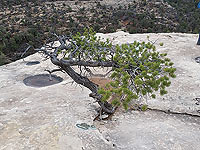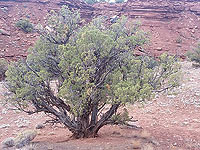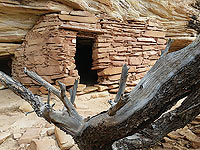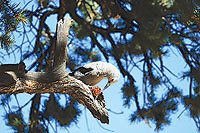When locals talk about the “PJ,” they aren’t talking about their jammies. No, they are referring to the pinyon-juniper woodland that blankets the Colorado Plateau, as well as some other regions of the American Southwest. Occasionally, someone might call this woodland the “pygmy forest,” a reference to the small stature of the trees.
The two-needle pinyon (Pinus edulis) and Utah juniper (Juniperus osteosperma) are the two main species that dominate this habitat. Farther west, into the drylands of Nevada and the eastern slope of the Sierras, the species change to single-leaf pinyon (Pinus monophylla) and western juniper (Juniperus occidentalis) and to the east, Rocky Mountain juniper replaces the Utah juniper. Spanish explorers in the region in the 1600s called the trees pino piñonero which has been modified to the modern-day piñon.
 In Southeastern Utah, the PJ extends from around 5,000 feet to 7,500 feet in elevation. Associated shrubs in this community include Gambel’s oak, Fremont’s mahonia, Utah serviceberry, antelope bitterbrush, and big sagebrush, and savannahs of grasses and forbs are interspersed amongst the woodlands providing habitat for mule deer, mountain lions, coyotes, jack rabbits, and other wildlife species.
In Southeastern Utah, the PJ extends from around 5,000 feet to 7,500 feet in elevation. Associated shrubs in this community include Gambel’s oak, Fremont’s mahonia, Utah serviceberry, antelope bitterbrush, and big sagebrush, and savannahs of grasses and forbs are interspersed amongst the woodlands providing habitat for mule deer, mountain lions, coyotes, jack rabbits, and other wildlife species.
Historically, both trees were important to indigenous people, the Native Americans that have been inhabiting this region for over 12,000 years. Pinyons provided not only a fuel source, waterproofing pitch, and building materials, but also an important food source – pinyon nuts.
During “mast” years when the trees produce an abundance of seeds, Native Americans harvested and stored the seeds for future use. According to David B. Williams in his book A Naturalist’s Guide to Canyon Country, he writes, “…the edible nuts…contain over 3,000 calories per pound.” That’s a pretty important food resource for a hunter-gatherer community or a modern-day gleaner.
But humans aren’t the only ones interested in these nuts. Small rodents and birds such as Clark’s nutcrackers and pinyon jays also harvest and cache some of the seeds for future use. The birds and mammals have excellent recall of where they stored the nuts, and a study of jays in the Flagstaff area by researchers from New Mexico State University, found that caching took place mostly in the fall and cache recovery was highest in winter. Some of the birds in the study were observed recaching dug up seeds, probably to avoid competition between jays for this rich resource.
 In contrast to the pinyon’s needle-like leaves, the juniper has scale-like leaves. Often called “cedars,” after these scaly leaves, the different cones and fruits place these trees in a different genus (Juniperus) than true cedars (Thuja). The juniper’s also produce a “berry” which is a seed enclosed within a hard shell that is wrapped in a waxy coat versus the small cone on a cedar. The waxy fruits resemble bluish berries but chomping into one would certainly send you to the dentist.
In contrast to the pinyon’s needle-like leaves, the juniper has scale-like leaves. Often called “cedars,” after these scaly leaves, the different cones and fruits place these trees in a different genus (Juniperus) than true cedars (Thuja). The juniper’s also produce a “berry” which is a seed enclosed within a hard shell that is wrapped in a waxy coat versus the small cone on a cedar. The waxy fruits resemble bluish berries but chomping into one would certainly send you to the dentist.
The gnarled and twisted trunks of the junipers also set them apart from the pitch-laden pinyon. The juniper is one of the classic plants of the Southwest desert as their half-dead appearance is interrupted by a single, spiraling limb bearing a patch of greenery. In the arid southwest both the growth and decay of these trees is a slow process moderated by the dry conditions; however, even after death, these charismatic trees reflect the beauty and struggle of life in this landscape.